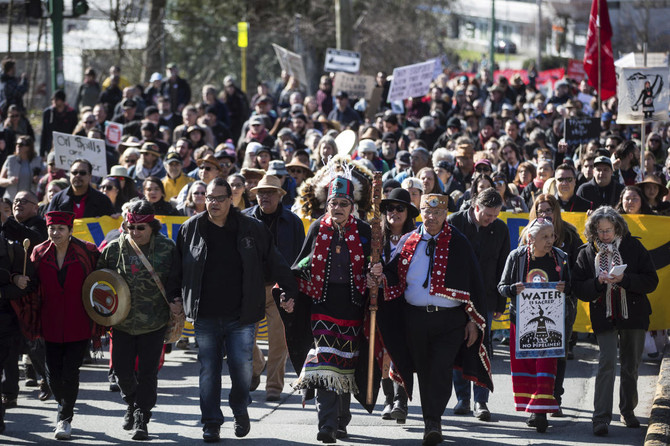BURNABY, British Columbia: Thousands of demonstrators marched Saturday to speak out against a pipeline expansion project that would nearly triple the flow of oil from Canada’s tar sands to the Pacific Coast.
Indigenous leaders led the march in the Vancouver suburb of Burnaby after telling the crowd that the day’s event was a celebration of unity, but they should be prepared in the future to “cross the line” with potential arrests.
“Our spiritual leaders today are going to claim back Burnaby Mountain,” Reuben George, a member of Tsleil-Waututh Nation, said before the crowd marched to the steady beat of drums and chants toward a site near Kinder Morgan’s storage tank farm in Burnaby.
Many protesters carried signs that read, “Water is life,” “No consent, no pipeline,” and “Keep it in the ground.” Others hoisted inflatable orcas and beat drums.
The Trans Mountain pipeline expansion by the Canadian division of Texas-based Kinder Morgan would dramatically increase the number of oil tankers traveling the shared waters between Canada and Washington state. Prime Minister Justin Trudeau approved the project in late 2016, saying it was in Canada’s best interest.
Kinder Morgan says it is moving ahead with preparatory work at two terminals in Burnaby but still needs to obtain numerous local permits and federal condition approvals to begin construction.
The project has drawn legal challenges and opposition from environmental groups and Native American tribes as well as from municipalities such as Vancouver and Burnaby. It’s also sparked a dispute between the provinces of Alberta, which has the world’s third largest oil reserves, and British Columbia.
Opponents say increasing the flow of oil sent by pipeline and boosting the number of ships to transport it would increase the risks of oil spills and potential impacts to fish, orcas and other wildlife.
Walking with her son Saturday, Cassandra Schodt, 28, said more fossil fuel development isn’t needed.
“There are better ways,” said the Port Coquitlam woman, adding that she worried about the ability to clean up oils that sink.
“We cannot sit by idly and let this project go with the way it would threaten our livelihood, our lives, our territories, our waters and our culture,” said Dustin Rivers, a Squamish Nation leader.
Supporters say the expansion of the pipeline, which has operated since 1953, will give Canada access to new global markets, provide jobs and millions of dollars in economic benefits and can be done responsibly.
Hours before the march, anti-pipeline activists began building a cedar structure on public land near Kinder Morgan’s tank farm. Will George, a member of the Tsleil-Waututh Nation, said that he plans to occupy the “watch house” to keep an eye on approaching threats such as the pipeline. “This is just the beginning,” he said, predicting that there would be arrests in the future.
An email to Trans Mountain seeking comment on the structure wasn’t immediately returned Saturday.
The activists made sure to keep their distance from the company’s property line after Kinder Morgan won a temporary injunction aimed at preventing protesters from coming within 55 yards (50 meters) of two terminals in Burnaby. Karen Mahon, the campaign director of the Stand.Earth environmental group helping to organize Saturday’s march, called it “an intimidation tactic.”
The Tsleil-Waututh Nation is one of several Native American tribes, called First Nations in Canada, that have legally challenged federal approval of the project, saying consultation with First Nations was not adequate.
Kanahus Manuel, a Canadian activist who was arrested during protests against the Dakota Access Pipeline in North Dakota, said Kinder Morgan does not have consent to run the pipeline through Secwepemc tribal territory.
“We never surrendered, ceded or released the land,” said Manuel, who is leading a group of activists building tiny homes that will be erected along the pipeline’s route in an attempt to assert indigenous sovereignty.
Kinder Morgan says it remains committed to environmental protection and world-leading spill response and that it has “support from First Nations communities whose reserves it intends to cross.” Tribal leaders on Friday disputed that.
Trudeau has defended the project. He has said the pipeline expansion is part of a larger national plan to meet emissions targets in the Paris Climate Accord that include a cap on tar sands emissions.
Canada’s tar sands are located almost exclusively in northern Alberta and contain an estimated 167 billion barrels of oil, according to the province. Tar sands, also referred to as oil sands, are a mixture of water, clay, sand and bitumen, a heavy viscous oil.
Trudeau said Alberta needs to export its oil outside of the US to get better prices and that “a modern pipeline can be very carefully monitored and can be done safely.”
Kinder Morgan has said the expanded pipeline capacity — from 300,000 to 890,000 barrels of oil per day — would allow oil companies to access growing markets in Asia and US states, including Washington state and California. The new pipeline would parallel the existing 713-mile (1,150-kilometer) pipeline route.
The project would carry oil from near Edmonton, Alberta, to a terminal in Burnaby, British Columbia. From there, vessels would generally travel through Haro Strait near Washington state’s San Juan Island and on to the Pacific Ocean.
Three new berths at the Westridge Marine Terminal in Burnaby would accommodate increased tanker traffic — from five to 35 vessels monthly.
Canada’s National Energy Board recommended the project’s approval in 2016, with 157 conditions. It said the project was in the public’s interest, but noted it would increase greenhouse gas emissions and that project-related marine vessels would have “significant adverse effects” on endangered southern resident killer whales, the orcas that spend time in the inland waters of Washington state.
“We’re deeply concerned about the impacts that a spill is going to have. It’s not a question of if, it’s when,” said Jay Julius, chairman of the Lummi Nation, one of several US tribes that had testified before Canada regulators opposing the project.
Thousands march to protest Canada pipeline expansion project
Thousands march to protest Canada pipeline expansion project

Czech Prime Minister Babiš faces confidence vote as government shifts Ukraine policy

- “I’d like to make it clear that the Czech Republic and Czech citizens will be first for our government,” Babiš said
- Babiš has rejected any financial aid for Ukraine and guarantees for EU loans
PRAGUE: The Czech Republic’s new government led by populist Prime Minister Andrej Babiš was set to face a mandatory confidence vote in Parliament over its agenda aimed at steering the country away from supporting Ukraine and rejecting some key European Union policies.
The debate in the 200-seat lower house of Parliament, where the coalition has a majority of 108 seats, began Tuesday. Every new administration must win the vote to govern.
Babiš, previously prime minister in two governments from 2017-2021, and his ANO, or YES, movement, won big in the country’s October election and formed a majority coalition with two small political groups, the Freedom and Direct Democracy anti-migrant party and the right-wing Motorists for Themselves.
The parties, which share admiration for US President Donald Trump, created a 16-member Cabinet.
“I’d like to make it clear that the Czech Republic and Czech citizens will be first for our government,” Babiš said in his speech in the lower house.
The political comeback by Babiš and his new alliance with two small government newcomers are expected to significantly redefine the nation’s foreign and domestic policies.
Unlike the previous pro-Western government, Babiš has rejected any financial aid for Ukraine and guarantees for EU loans to the country fighting the Russian invasion, joining the ranks of Viktor Orbán of Hungary and Robert Fico of Slovakia.
But his government would not abandon a Czech initiative that managed to acquire some 1.8 million much-needed artillery shells for Ukraine only last year on markets outside the EU on condition the Czechs would only administer it but would not contribute money.
The Freedom party sees no future for the Czechs in the EU and NATO, and wants to expel most of 380,000 Ukrainian refugees in the country.
The Motorists, who are in charge of the environment and foreign ministries, rejected the EU Green Deal and proposed revivals of the coal industry.














